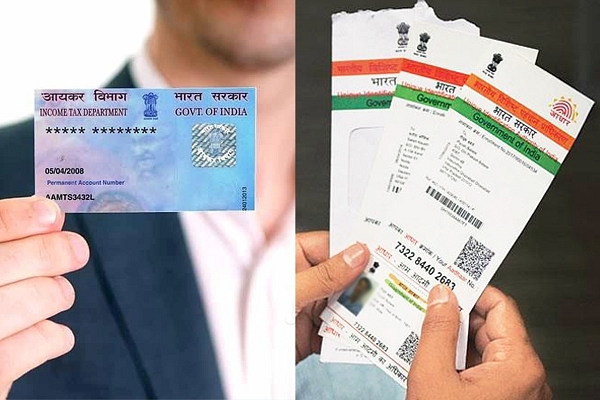
How PAN-Aadhaar Inter-Changeability Will Massively Enhance The Taxman’s Capabilities
If every Aadhaar number is given a PAN number gratis, India will have a database of direct taxpayers and beneficiaries on an unprecedented scale.
In future, it will become near impossible to avoid a tax footprint for anyone who is eligible to pay tax.
You can also read this article in Hindi- कैसे पैन और आधार में विनिमय भारत की कर क्षमता को बढ़ा सकता है
By obliterating the line separating an income-tax number (PAN) from an ID number (Aadhaar), India is potentially on the road to a single effective tax-cum-social security number.
In her budget speech, Finance Minister Nirmala Sitharaman said that those who did not have a PAN number could file returns using their Aadhaar number; where they have to quote a PAN number to buy big ticket items (like automobiles or jewellery), Aadhaar will again be valid.
In theory, this has been explained as a simplification for taxpayers. But, in reality, what this will enable is the creation of PAN numbers for millions of Aadhaar users who may or may not be filing returns.
Every time an Aadhaar is used to buy something, at the back end a PAN number will be generated and sent to the user. Thus, willy-nilly, there will be an ever-expanding base of PAN users. Where you use Aadhaar, you now get a PAN gratis.
At the other end of the spectrum, anyone drawing benefits from the state will compulsorily have to use Aadhaar. And if PAN numbers are generated for them too, we are essentially talking of a social security number where full details of taxpayers and state subsidy/beneficiary receivers will be available on a single platform.
As at the end of fiscal 2017-18, India had 54.3 million tax return filers, and 74.1 million taxpayers. Around 36 per cent of taxpayers paid taxes but did not file returns. Most of these taxes may have been collected through deductions at source.
In her budget speech, Sitharaman noted that in 2018-19, there were 84.4 million taxpayers, and assuming that the proportion of tax filers is similar to the year before, the gap between taxpayers and tax filers will be nearly 20.5 million.
At the very least, in the first round, we could see massive additions to the PAN base in the coming year, as most taxpayers (but not tax filers) get PAN allocations.
If, at some point, every Aadhaar number is given a PAN number gratis, India will have a database of direct taxpayers and beneficiaries on an unprecedented scale.
The overall implications, both on the positive and negative sides, are the following:
In future, it will become near impossible to avoid a tax footprint for anyone who is eligible to pay tax. Avoidance is no longer an option, even if you use cash for all your transactions, unless all you do is buy daily necessities.
Each PAN number can generate both positive tax contributions and negative taxation numbers (ie, subsidy payments on LPG, or old age pension payments), and it will become easier for today’s beneficiaries to be gently moved into the net taxpaying category. The state will have a complete picture of what you pay as tax, and what you receive as benefits. It will know your net tax position.
If millions of Indian businesses and goods and services taxpayers also get linked this way through Aadhaar, we are talking of an end-to-end system of understanding where the money comes and goes.
A bonus: at some point, the taxpayer can be told directly how his payments are helping which segment of the poor, in almost the same way in which some charity organisations are able to seek individual donations to put a specific child through school, or finance his mid-day meal.
Knowing where your tax money is going can be a great motivator for compliance. When you don’t know whether your tax money is going to the needy or some fat bureaucrat who squanders it, you are less likely to want to pay tax. If government starts sharing data on the direct costs of its schemes, and the administrative costs, the citizen will know which schemes are duds.
The government can use PAN-Aadhaar interchangeability for financial surveillance and/or coaxing taxpayers to contribute specifically for specific causes.
In future, it may become possible for taxpayers to pay for specific causes over and above what they are obliged to pay by way of tax rates. It means we can move towards a lower basic tax regime, and additionally ask citizens to pay for specific line items in the budget which are optional.
For example, if you want to pay more only for educating orphans, you can do so over and above your normal tax rate because you can get certainty on where your money is going.